Insights on In Situ Combustion Modeling Based on a Ramped Temperature Oxidation Experiment for Oil Sand Bitumen
Abstract
:1. Introduction
2. Description of the RTO Test
3. Experimental Results
4. Numerical Simulation of the RTO Test
4.1. Model Description
4.2. History Matching and Numerical Results
5. Conclusions
Author Contributions
Funding
Data Availability Statement
Acknowledgments
Conflicts of Interest
References
- Sun, X.F.; Song, Z.Y.; Cai, L.F.; Zhang, Y.Y.; Li, P. Phase behavior of heavy oil–solvent mixture systems under reservoir conditions. Pet. Sci. 2020, 17, 1683–1698. [Google Scholar] [CrossRef]
- Anderson, T.I.; Kovscek, A.R. Optimization and uncertainty quantification of in situ combustion chemical reaction models. Fuel 2022, 319, 123683. [Google Scholar] [CrossRef]
- Sharma, J.; Dean, J.; Aljaberi, F.; Altememee, N. In-situ combustion in Bellevue field in Louisiana–History, current state and future strategies. Fuel 2021, 284, 118992. [Google Scholar] [CrossRef]
- Belgrave, J.D.M.; Moore, R.G.; Ursenbach, M.G.; Bennion, D.W. A comprehensive approach to in-situ combustion modeling. SPE Adv. Technol. Ser. 1993, 1, 98–107. [Google Scholar] [CrossRef]
- Duiveman, M.W.; Herwin, H.; Grivot, P. Integrated management of water, lean gas, and air injection: The successful ingredients to EOR projects on the mature Handil Field. In Proceedings of the SPE Asia Pacific Oil and Gas Conference and Exhibition, Jakarta, Indonesia, 5–7 April 2005. [Google Scholar] [CrossRef]
- Hongmin, Y.; Shaoran, R.; Jiexiang, W.; Baoquan, Y.; Hongyun, S. Numerical simulation study on enhanced oil recovery by air injection process in Shengli Oilfield. Oil Drill. Prod. Technol. 2008, 30, 105–109. [Google Scholar]
- Moore, R.G.; Mehta, S.A.; Ursenbach, M.G.; Gutierrez, D. Potential for in situ combustion in depleted conventional oil reservoirs. In Proceedings of the SPE Improved Oil Recovery Symposium, Tulsa, OK, USA, 14–18 April 2012. [Google Scholar] [CrossRef]
- Wei, W.; Wang, J.; Afshordi, S.; Gates, I.D. Detailed analysis of Toe-to-Heel Air Injection for heavy oil production. J. Pet. Sci. Eng. 2020, 186, 106704. [Google Scholar] [CrossRef]
- Gates, I.D.; Larter, S.R. Energy efficiency and emissions intensity of SAGD. Fuel 2014, 115, 706–713. [Google Scholar] [CrossRef]
- Yang, M.; Harding, T.G.; Chen, Z. Field-scale modeling of hybrid steam and in-situ-combustion recovery process in oil-sands reservoirs using dynamic gridding. SPE Reserv. Eval. Eng. 2020, 23, 311–325. [Google Scholar] [CrossRef]
- Kapadia, P.R.; Kallos, M.S.; Gates, I.D. A review of pyrolysis, aquathermolysis, and oxidation of Athabasca bitumen. Fuel Process. Technol. 2015, 131, 270–289. [Google Scholar] [CrossRef]
- Pu, W.; Zhao, S.; Hu, L.; Varfolomeev, M.A.; Yuan, C.; Wang, L.; Rodionov, N.O. Thermal effect caused by low temperature oxidation of heavy crude oil and its in-situ combustion behavior. J. Pet. Sci. Eng. 2020, 184, 106521. [Google Scholar] [CrossRef]
- Barzin, Y.; Moore, R.G.; Mehta, S.A.; Ursenbach, M.G.; Tabasinejad, F. Impact of distillation on the combustion kinetics of high-pressure air injection (HPAI). In Proceedings of the SPE Improved Oil Recovery Symposium, Tulsa, OK, USA, 24–28 April 2010. [Google Scholar]
- Gutierrez, D.; Moore, R.G.; Ursenbach, M.G.; Mehta, S.A. The ABCs of in-situ-combustion simulations: From laboratory experiments to field scale. J. Can. Pet. Technol. 2012, 51, 256–267. [Google Scholar] [CrossRef]
- Bondarenko, T.; Khakimova, L.; Cheremisin, A.; Spasennykh, M. High-Pressure Air Injection Laboratory and Numerical Modelling in Bazhenov Source Rocks. In Proceedings of the SPE Russian Petroleum Technology Conference, Moscow, Russia, 16–18 October 2017. [Google Scholar] [CrossRef]
- Mallory, D.G.; Moore, R.G.; Mehta, S.A. Ramped temperature oxidation testing and in situ combustion projects. Energy Fuels 2018, 32, 8040–8056. [Google Scholar] [CrossRef]
- Khakimova, L.; Bondarenko, T.; Cheremisin, A.; Myasnikov, A.; Varfolomeev, M. High pressure air injection kinetic model for Bazhenov Shale Formation based on a set of oxidation studies. J. Pet. Sci. Eng. 2019, 172, 1120–1132. [Google Scholar] [CrossRef]
- Jia, N.; Moore, R.G.; Mehta, S.A.; Ursenbach, M.G. Kinetic modelling of thermal cracking and low temperature oxidation reactions. J. Can. Pet. Technol. 2006, 45. [Google Scholar] [CrossRef]
- Zhao, S.; Pu, W.; Sun, B.; Gu, F.; Wang, L. Comparative evaluation on the thermal behaviors and kinetics of combustion of heavy crude oil and its SARA fractions. Fuel 2019, 239, 117–125. [Google Scholar] [CrossRef]
- dos Santos, R.G.; Vidal Vargas, J.A.; Trevisan, O.V. Thermal analysis and combustion kinetic of heavy oils and their asphaltene and maltene fractions using accelerating rate calorimetry. Energy Fuels 2014, 28, 7140–7148. [Google Scholar] [CrossRef]
- Vargas, J.A.V.; dos Santos, R.G.; Trevisan, O.V. Evaluation of crude oil oxidation by accelerating rate calorimetry: Effects of combustion process variables on thermal and kinetic parameters. J. Therm. Anal. Calorim. 2013, 113, 897–908. [Google Scholar] [CrossRef]
- Kök, M.V.; Karacan, Ö.; Pamir, R. Kinetic analysis of oxidation behavior of crude oil SARA constituents. Energy Fuels 1998, 12, 580–588. [Google Scholar] [CrossRef]
- Freitag, N.P.; Verkoczy, B. Low-temperature oxidation of oils in terms of SARA fractions: Why simple reaction models don’t work. J. Can. Pet. Technol. 2005, 44, 54–61. [Google Scholar] [CrossRef]
- Gutiérrez, D.; Moore, R.G.; Mehta, S.A.; Ursenbach, M.; Bernal, A. Phase-behavior modeling of oils in terms of saturates/aromatics/resins/asphaltenes fractions. SPE Reserv. Eval. Eng. 2019, 22, 1–015. [Google Scholar] [CrossRef]
- Christensen, J.R.; Darche, G.; Dechelette, B.; Ma, H.; Sammon, P.H. Applications of dynamic gridding to thermal simulations. In Proceedings of the SPE International Thermal Operations and Heavy Oil Symposium and Western Regional Meeting, Bakersfield, CA, USA, 16–18 March 2004. [Google Scholar] [CrossRef]
- De Zwart, A.H.; van Batenburg, D.W.; Blom, C.; Tsolakidis, A.; Glandt, C.A.; Boerrigter, P. The modeling challenge of high pressure air injection. In Proceedings of the SPE Symposium on Improved Oil Recovery, Tulsa, OK, USA, 20–23 April 2008. [Google Scholar] [CrossRef]
- Kovscek, A.R.; Castanier, L.M.; Gerritsen, M.G. Improved predictability of in-situ-combustion enhanced oil recovery. SPE Reserv. Eval. Eng. 2013, 16, 172–182. [Google Scholar] [CrossRef]
- Nissen, A.; Zhu, Z.; Kovscek, A.; Castanier, L.; Gerritsen, M. Upscaling kinetics for field-scale in-situ-combustion simulation. SPE Reserv. Eval. Eng. 2015, 18, 158–170. [Google Scholar] [CrossRef]
- Gutierrez, D.; Skoreyko, F.; Moore, R.G.; Mehta, S.A.; Ursenbach, M.G. The challenge of predicting field performance of air injection projects based on laboratory and numerical modelling. J. Can. Pet. Technol. 2009, 48, 23–33. [Google Scholar] [CrossRef]
- Moore, R.G.; Belgrave, J.D.M.; Mehta, R.; Ursenbach, M.; Laureshen, C.J.; Xi, K. Some insights into the low-temperature and high-temperature in-situ combustion kinetics. In Proceedings of the SPE/DOE Enhanced Oil Recovery Symposium, Tulsa, OK, USA, 22–24 April 1992. [Google Scholar] [CrossRef]
- Moore, R.G.; Mehta, S.A.; Ursenbach, M.G. A guide to high pressure air injection (HPAI) based oil recovery. In Proceedings of the SPE/DOE Improved Oil Recovery Symposium, Tulsa, OK, USA, 13–17 April 2002. [Google Scholar] [CrossRef]
- Yang, J.; Xu, Q.; Jiang, H.; Shi, L. Reaction model of low asphaltene heavy oil from ramped temperature oxidation experimental analyses and numerical simulations. Energy 2021, 219, 119669. [Google Scholar] [CrossRef]
- Wang, Y.; Ren, S.; Zhang, L.; Deng, J.; Peng, X.; Cheng, H. New insights into the oxidation behaviors of crude oils and their exothermic characteristics: Experimental study via simultaneous TGA/DSC. Fuel 2018, 219, 141–150. [Google Scholar] [CrossRef]
- Huang, S.; Sheng, J.J. A practical method to obtain kinetic data from TGA (thermogravimetric analysis) experiments to build an air injection model for enhanced oil recovery. Fuel 2017, 206, 199–209. [Google Scholar] [CrossRef]
- Li, Y.; Liao, G.; Wang, Z.; Su, R.; Ma, S.; Zhang, H.; Shi, Q. Molecular composition of low-temperature oxidation products in a simulated crude oil In-situ combustion. Fuel 2022, 316, 123297. [Google Scholar] [CrossRef]
- Yang, M.; Harding, T.G.; Chen, Z. Numerical investigation of the mechanisms in co-injection of steam and enriched air process using combustion tube tests. Fuel 2019, 242, 638–648. [Google Scholar] [CrossRef]
- Fassihi, M.R.; Brigham, W.E.; Ramey, H.J., Jr. Reaction kinetics of in-situ combustion: Part 1-observations. Soc. Pet. Eng. J. 1984, 24, 399–407. [Google Scholar] [CrossRef]
- Burger, J.G. Chemical aspects of in-situ combustion-heat of combustion and kinetics. Soc. Pet. Eng. J. 1972, 12, 410–422. [Google Scholar] [CrossRef]
- Khakimova, L.; Askarova, A.; Popov, E.; Moore, R.G.; Solovyev, A.; Simakov, Y.; Cheremisin, A. High-pressure air injection laboratory-scale numerical models of oxidation experiments for Kirsanovskoye oil field. J. Pet. Sci. Eng. 2020, 188, 106796. [Google Scholar] [CrossRef]
- Arrhenius, S. Über die Dissociation der in Wasser gelösten Stoffe. Z. Phys. Chem. 1887, 1, 631–648. [Google Scholar] [CrossRef]
- Walther, C. The evaluation of viscosity data. Erdol. Teer 1931, 7, 382–384. [Google Scholar]
- Mehrotra, A.K. Modeling the effects of temperature, pressure, and composition on the viscosity of crude oil mixtures. Ind. Eng. Chem. Res. 1990, 29, 1574–1578. [Google Scholar] [CrossRef]
- Bhattacharya, S.; Mallory, D.G.; Moore, R.G.; Ursenbach, M.G.; Mehta, S.A. Vapor phase combustion in Accelerating Rate Calorimetry for air-injection EOR processes. In Proceedings of the SPE Western Regional Meeting, Anchorage, AK, USA, 23–26 May 2016. [Google Scholar] [CrossRef]

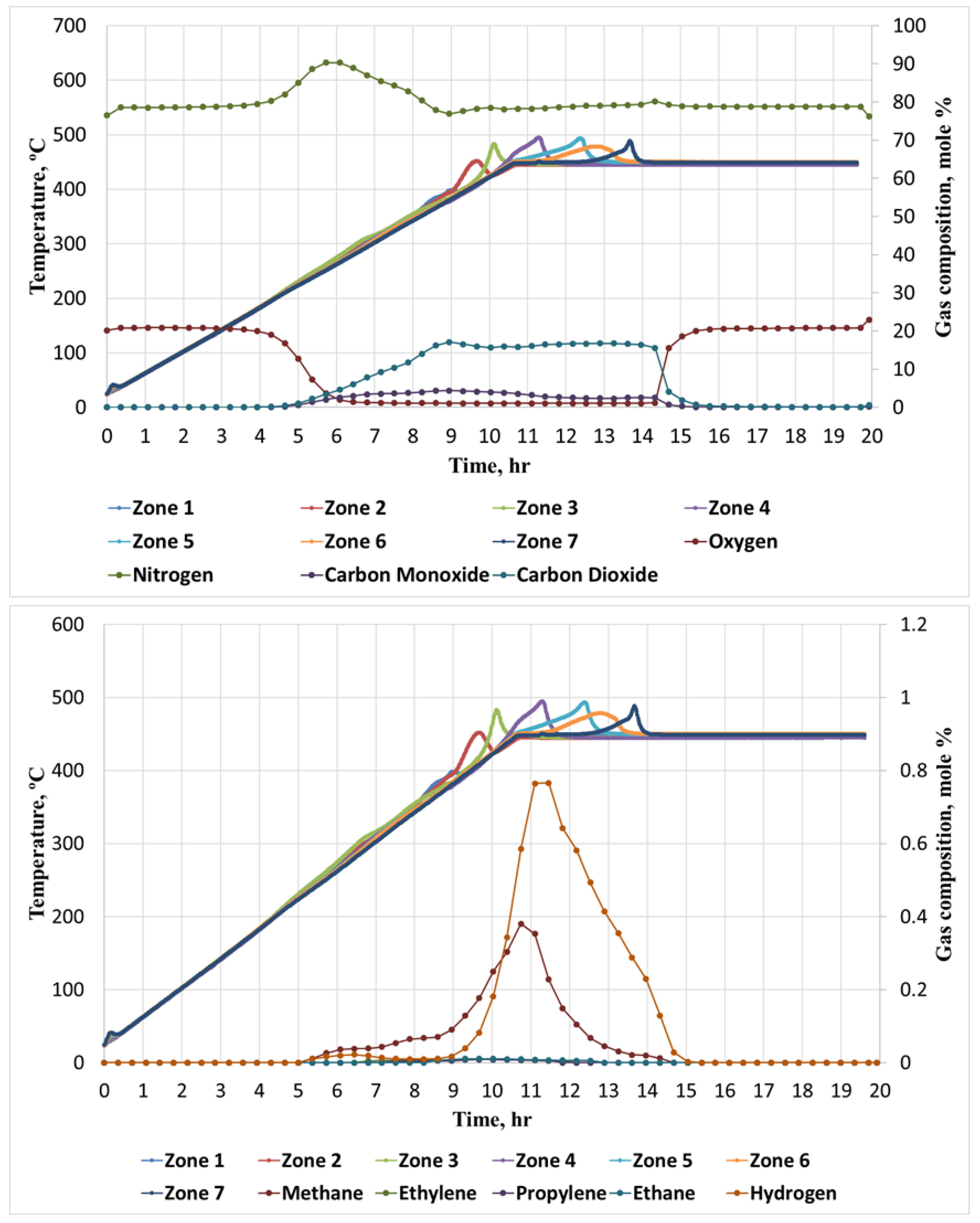
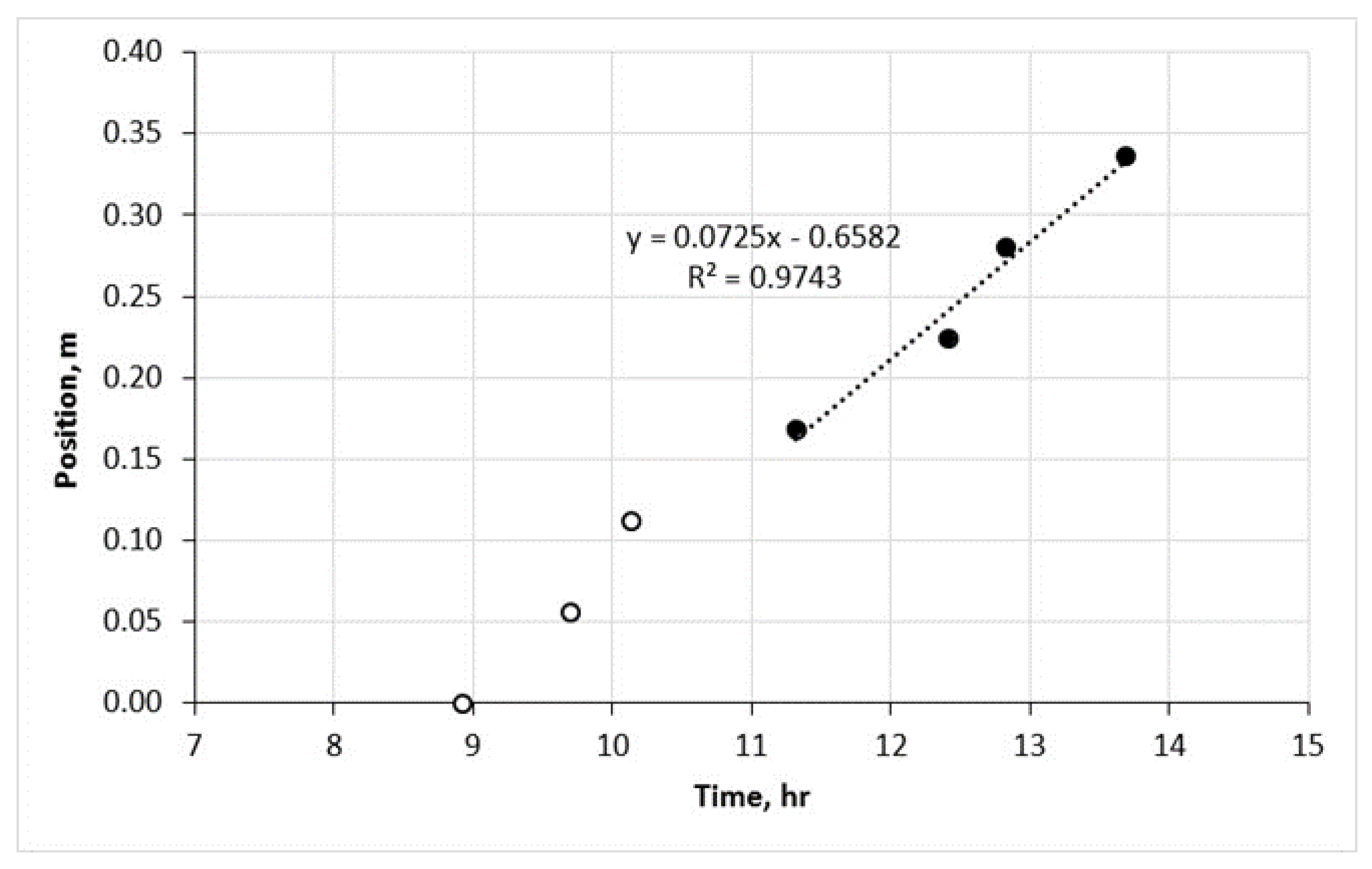

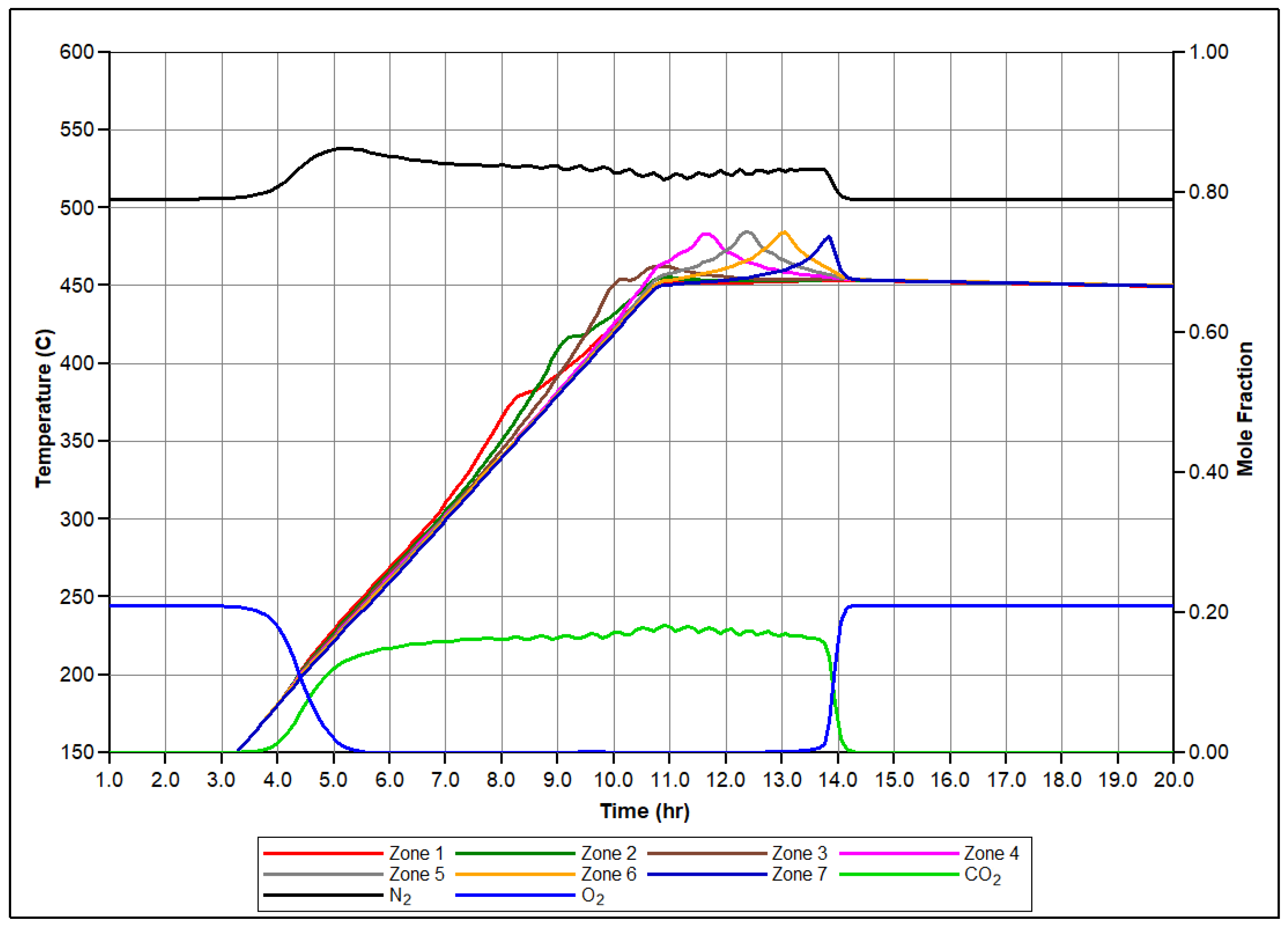
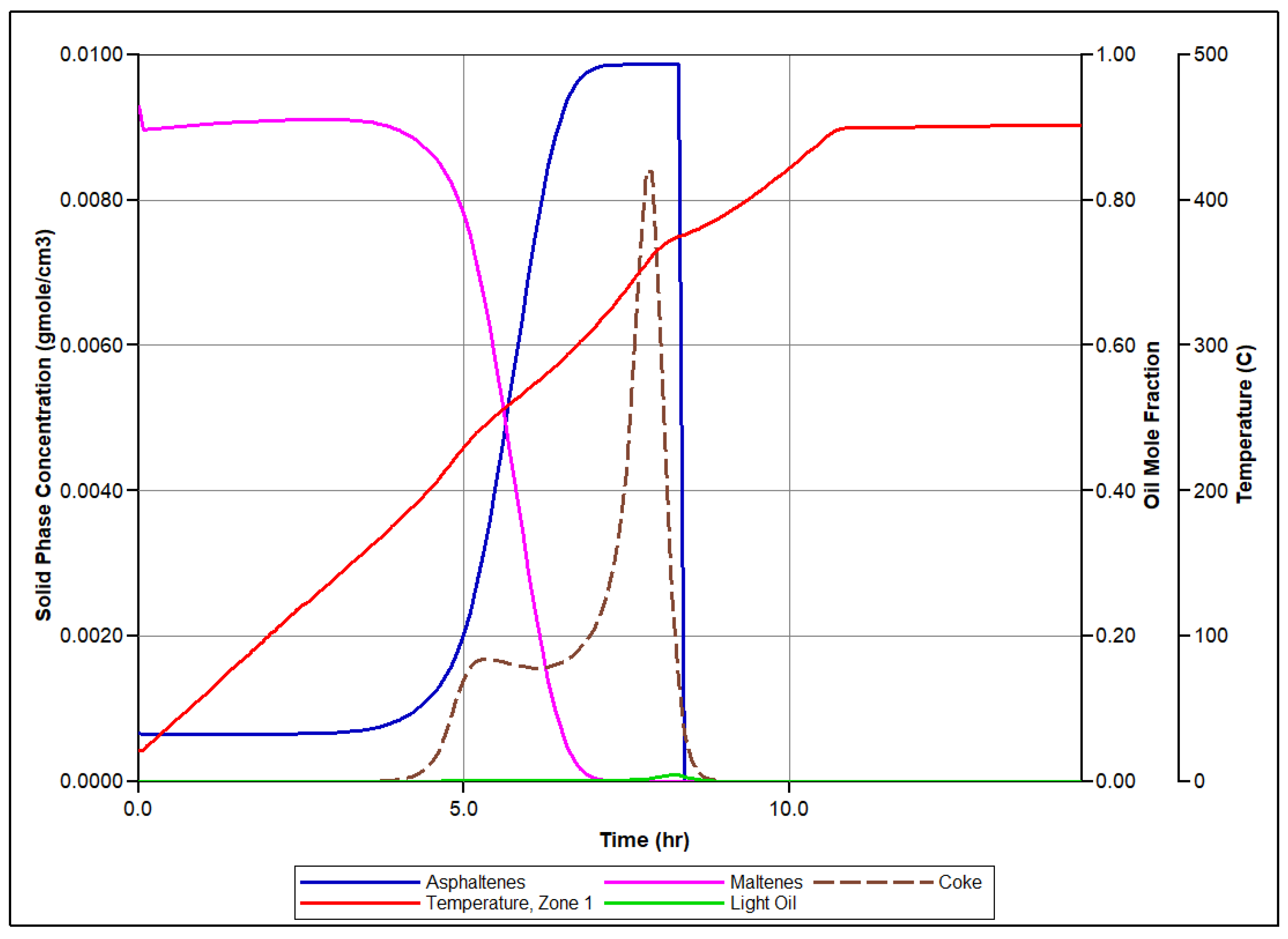
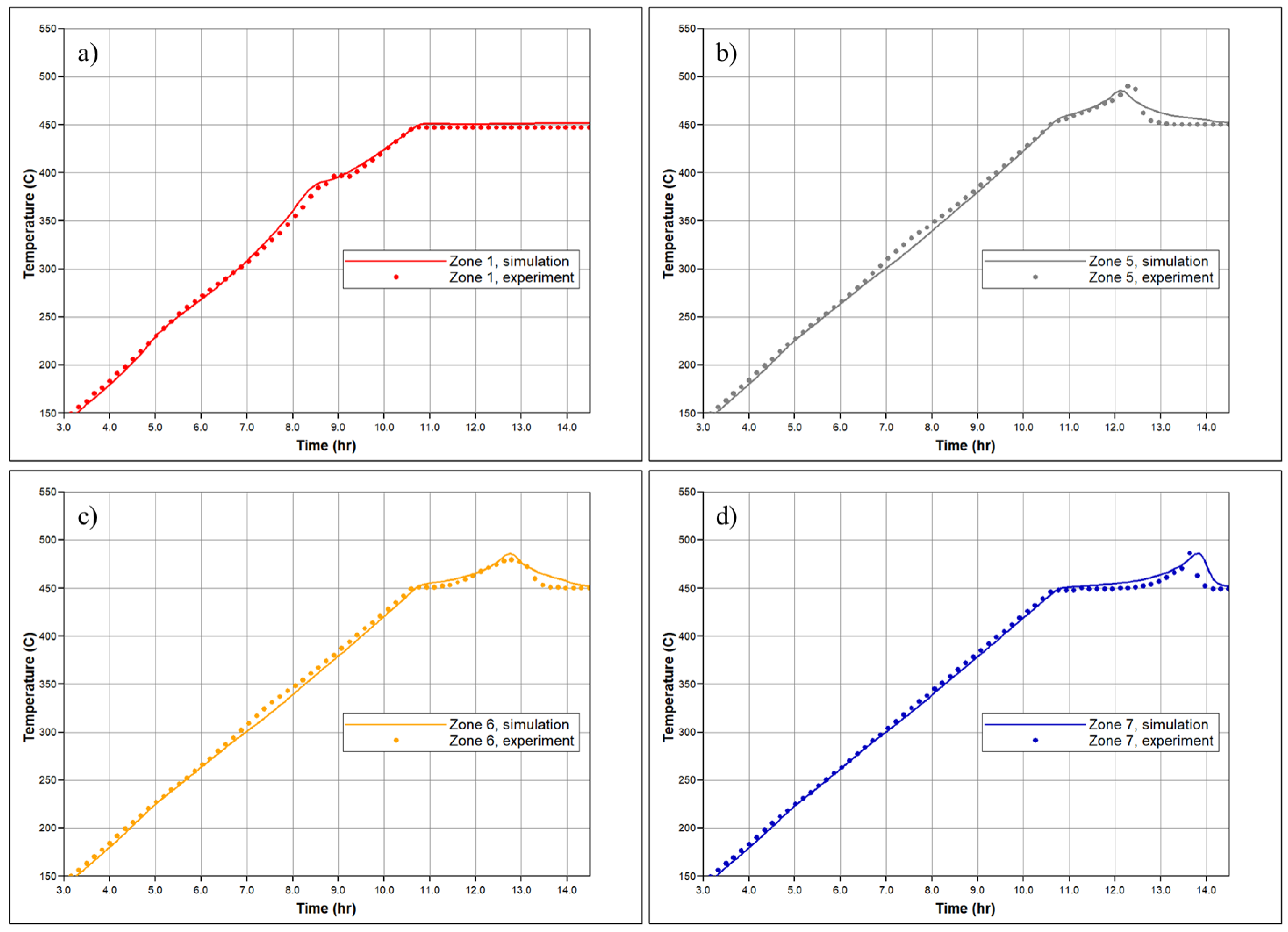
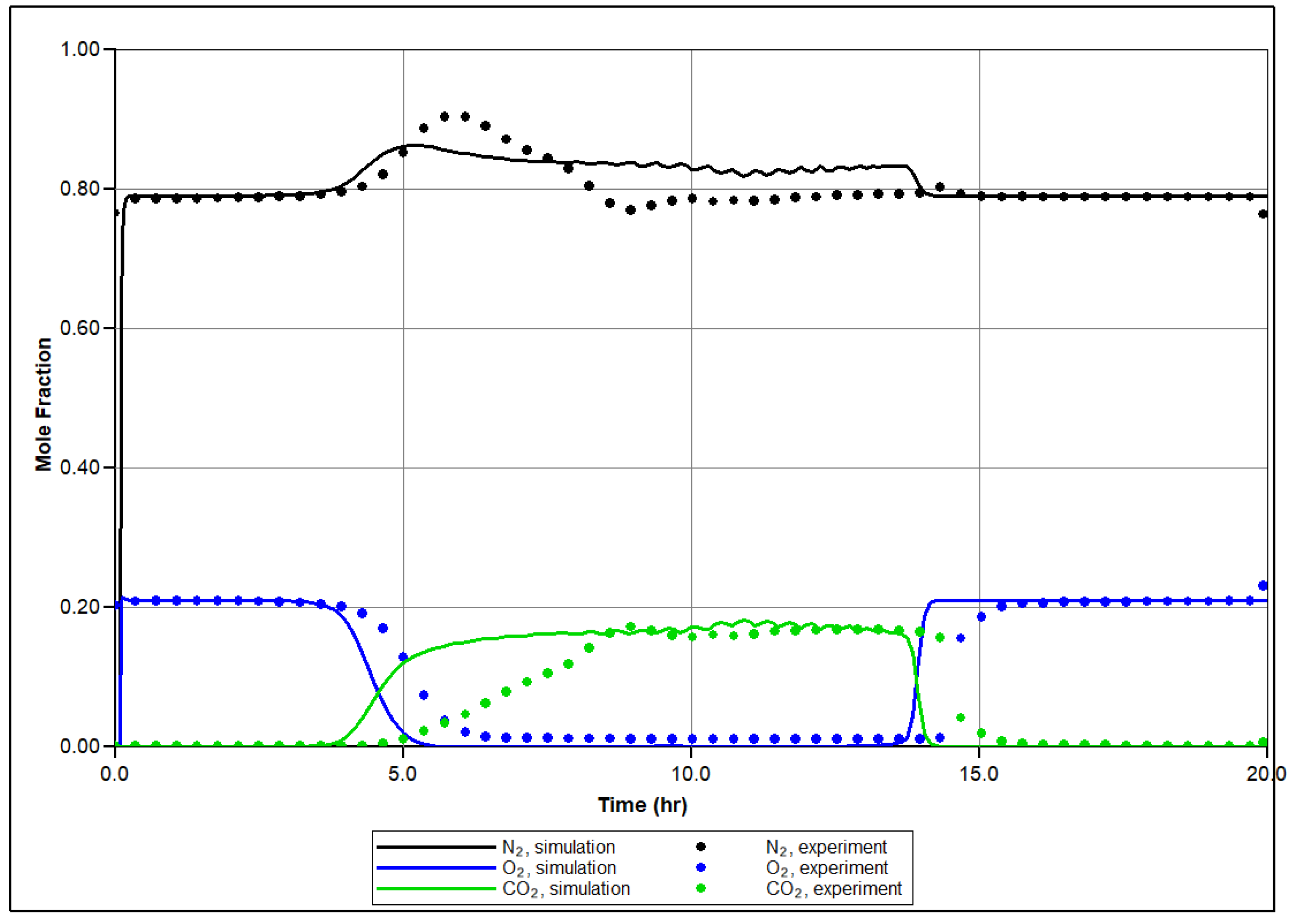
| Porosity, % | 48 |
| Temperature, °C | 25 |
| Water saturation | 0.013 |
| Gas saturation | 0.564 |
| Oil saturation | 0.423 |
| Initial mole fraction of Asphaltenes, wt% | 0.059 |
| 1386 at 25 °C | |
| Bitumen viscosity, cP | 342.2 at 40 °C |
| 159.7 at 50 °C | |
| 956 at 20 °C | |
| Bitumen density, kg/m3 | 941 at 40 °C |
| 927 at 60 °C |
| Component | Molar Mass, g/mol | Critical Temperature, °C | Critical Pressure, kPa | KV1 | KV4 | KV5 |
|---|---|---|---|---|---|---|
| LO (Light Oil) | 212 | 433.9 | 1520 | 2.4 × 106 | −1610.0 | −283.6 |
| Malt (Maltenes) | 329 | 612 | 1480 | 1.3 × 108 | −8635.0 | −273.2 |
| Asph (Asphaltenes) | 1092 | 1399.2 | 162.5 | 0 | −11,987.7 | −273.12 |
| CO2 | 44 | 31.05 | 7376.5 | 8.6 × 108 | −3102.2 | −248.1 |
| Coke | 12.498 | - | - | - | - | - |
| Reaction | Frequency Factor | Activation Energy, kJ/mol | Enthalpy of the Reaction, kJ/mol |
|---|---|---|---|
| 1 | 1.05 × 108 h−1 kPa−0.4246 | 86.73 | 5474.2 |
| 2 | 1.03 × 102 h−1 kPa−1 | 34.86 | 553.7 |
| 3 | 1.31 × 108 h−1 kPa−4.7627 | 185.62 | 5564.0 |
| 4 | 1.02 × 102 h−1 kPa−1 | 100.00 | 523.0 |
| 5 | 2.11 × 1012 h−1 | 181.04 | 0 |
| Mass of Cumulative Water, g | Mass of Cumulative Oil, g | Mass of Cumulative Carbon Dioxide, g | |
|---|---|---|---|
| Experiment | 12.38 | 11.26 | 18.7 |
| Simulation | 11.97 | 11.71 | 21.83 |
Disclaimer/Publisher’s Note: The statements, opinions and data contained in all publications are solely those of the individual author(s) and contributor(s) and not of MDPI and/or the editor(s). MDPI and/or the editor(s) disclaim responsibility for any injury to people or property resulting from any ideas, methods, instructions or products referred to in the content. |
© 2023 by the authors. Licensee MDPI, Basel, Switzerland. This article is an open access article distributed under the terms and conditions of the Creative Commons Attribution (CC BY) license (https://creativecommons.org/licenses/by/4.0/).
Share and Cite
Khakimova, L.; Popov, E.; Cheremisin, A. Insights on In Situ Combustion Modeling Based on a Ramped Temperature Oxidation Experiment for Oil Sand Bitumen. Energies 2023, 16, 6738. https://doi.org/10.3390/en16186738
Khakimova L, Popov E, Cheremisin A. Insights on In Situ Combustion Modeling Based on a Ramped Temperature Oxidation Experiment for Oil Sand Bitumen. Energies. 2023; 16(18):6738. https://doi.org/10.3390/en16186738
Chicago/Turabian StyleKhakimova, Lyudmila, Evgeny Popov, and Alexey Cheremisin. 2023. "Insights on In Situ Combustion Modeling Based on a Ramped Temperature Oxidation Experiment for Oil Sand Bitumen" Energies 16, no. 18: 6738. https://doi.org/10.3390/en16186738
APA StyleKhakimova, L., Popov, E., & Cheremisin, A. (2023). Insights on In Situ Combustion Modeling Based on a Ramped Temperature Oxidation Experiment for Oil Sand Bitumen. Energies, 16(18), 6738. https://doi.org/10.3390/en16186738







